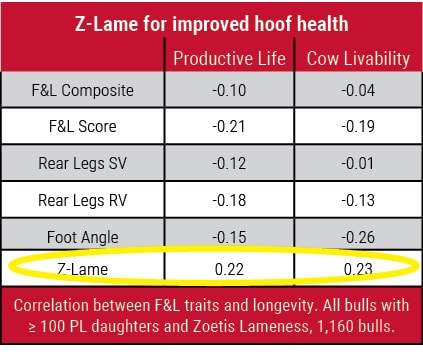Conventional thinking is considered tried and true, going unquestioned; but is that always the best approach?
Through National Animal Health Monitoring¹, we know lameness is among one of the top-five reasons dairy cows leave the herd. Obviously, management practices play a big role, but so do genetics.
Historically, we’ve selected sires for traits like Foot Angle, Legs Side View, and Feet and Leg Composite (FLC). With years of experience, we should see improvement in the incidence of lameness, but we haven’t. Maybe, it’s time to challenge conventional thinking?
Studies to analyze lameness traits show indirect selection to improve lameness resistance, using a variety of conformation traits, hasn’t been effective. Fortunately, new tools that more directly address lameness resistance have been developed.

Publicly available since 2016, Z-Lame is a lameness evaluation from Zoetis that represents data from health events recorded in a wide range of CLARIFIDE-tested, commercial-dairy farms. Lameness evaluations are expressed as standardized transmitting abilities (STAs) and usually range between 85 and 115, with 100 as the average. Higher values indicate more resistance to lameness and are preferred.
Validation studies published in the Journal of Dairy Science® document the predictive power of lameness evaluations.² Additionally, Select Sires studied lameness evaluations and determined there was a positive correlation between STA values for lameness and predictive transmitting abilities (PTAs) for Productive Life (PL) and Livability (LIV).² Simply put, cows with a higher Z-Lame score are the same cows that possess high PL and LIV traits.
If you’re relying on confirmation traits to improve lameness resistance, it may be time to challenge conventional thinking. If you’re interested in learning more about this topic, talk to your CentralStar team. We also recommend reading Lameness Traits: Underused and Underestimated by Chuck Sattler, vice president of genetic programs, Select Sires, Inc.
Sources: ¹National Animal Health Monitoring, 2014. ²Lameness Trait
